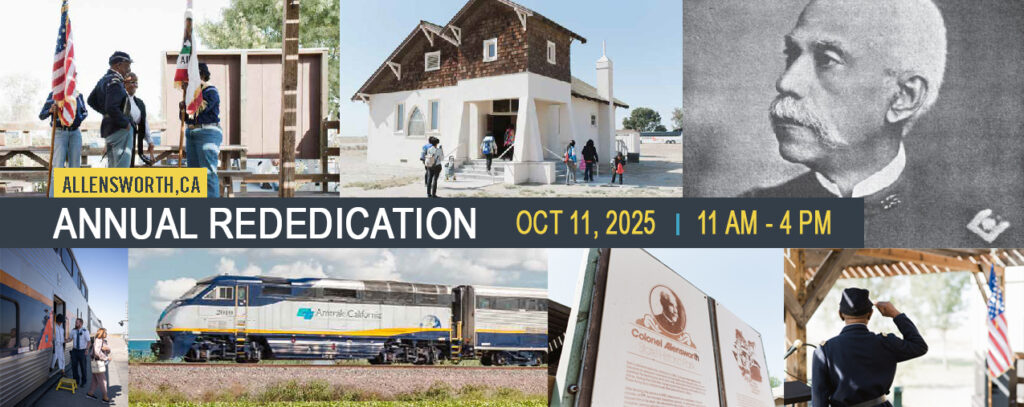Amtrak to run special trains to Colonel Allensworth State Historic Park 2025 Rededication Celebration Oct. 11
Tuesday, October 7th, 2025
Celebrating seven years of tradition, trains will once again bring visitors to honor site central to California’s African American history
Established in 1908, it was the state’s first self-governed Black township
By Harlo Pippenger, Consultant, Amtrak San Joaquins

(Stockton, CA) – Colonel Allensworth State Historic Park is holding its annual celebratory Rededication event on Saturday, October 11 from 11:00 AM to 4:00 PM. In partnership, Amtrak San Joaquins has scheduled a special stop at the park for multiple trains, bookable at exclusive half-price “Allensworth fares.”
Travelers from Northern California, the Bay Area and the Central Valley are invited to experience a scenic day trip aboard the Amtrak San Joaquins, arriving directly at the gates of this historic landmark and celebration. Attendees are encouraged to book now to secure their seats and to enjoy further savings by combining discounts, as detailed on the Amtrak San Joaquins Deals webpage.
Hosted by California State Parks, the Annual Rededication of Col. Allensworth State Historic Park honors the park’s original dedication in 1976. The event will feature food trucks, arts and crafts, guided tours of historic buildings, performances of music and dance, interactive experiences with time-period docents, and remarks from descendants of Colonel Allen Allensworth.
This year’s special Rededication train marks the seventh anniversary of Amtrak San Joaquins’ service to the Colonel Allensworth State Historic Park Rededication Celebration. Since that first ride in 2018, ridership to the event has grown dramatically, from just 97 passengers to more than 300 in 2024 and over 500 individuals traveling by train to the most recent Juneteenth 2025 Festival. Each year, more Californians are discovering the ease and joy of traveling by train to celebrate this historic community and the lasting impact it has had on the state’s heritage. With direct service and exclusive discounted fares, Amtrak San Joaquins is making it easier than ever for riders from across the state to be part of this meaningful celebration.
Founded in 1908 by Colonel Allen Allensworth, a former enslaved man, the town was designed to be a self-sustaining community where African Americans could live, work, and thrive. Today, you can witness the legacy of this trailblazing community come alive with captivating re-enactments, storytelling, and tours of the lovingly restored and reconstructed early 20th century buildings. Step into the Colonel’s house, walk through the halls of the historic schoolhouse and explore the church and library for an inspiring journey through a pivotal moment in history.
“California State Parks is proud to celebrate seven years of partnership with Amtrak San Joaquins in bringing visitors directly to Colonel Allensworth State Historic Park,” said Lori Wear, California State Parks. “This special train service has helped thousands of Californians experience the rich history and enduring legacy of Colonel Allensworth in an accessible, affordable, and memorable way. We’re beyond excited for this year and continuing this progress into the future.”
The southbound trains running for the event include trains 702 (10:55am arrival), 710 (11:54am arrival), and 712 (2:54 arrival). Northbound trains include 713 (8:56am arrival), 715 (12:56pm arrival), 717 (2:56pm arrival). When purchasing train tickets, a discount will automatically be applied. If eligible, riders can then combine this reduced ticket with additional savings regularly available which include:
- Infants under 2 years of age ride for free
- Children 2-12 years old ride half-price every day
- Seniors (62+ years of age) receive 15% off
- Veterans & active military members receive 15% off
- Disabled riders save 15% off
- View deals
Visitors attending the Rededication Celebration via the Amtrak San Joaquins trains will arrive at the Allensworth station (CNL), which will serve as a special stop for this event. Upon arrival, a complimentary 35-passenger shuttle provided by Tulare County Area Transit will transport riders between the train platform and the historic schoolhouse. Typically, a whistle stop available only to pre-booked groups, the Allensworth station (CNL) will be fully activated for travelers on October 11, offering a rare and seamless opportunity to experience this historic park by rail.
Train tickets to Colonel Allensworth State Historic Park can be booked online at the Colonel Allensworth landing page or contact Carmen Setness, community outreach coordinator for San Joaquin Regional Rail Commission (SJRRC), at csetness@sjrrc.com.
About Allensworth State Historic Park
The town of Allensworth is located in the heart of the Central Valley, about 30 miles north of Bakersfield. Boasting a rich history that is of interest to students, families, history buffs, minority community organizations, and anyone else looking to spend a fun day exploring the historic community and its restored buildings. In 1908, Allensworth was established as a town founded, financed and governed by African Americans. There were a series of challenges impeding the town’s long-term survival, but it is celebrated as a key historical icon. In 1974 California State Parks purchased the land in order to maintain it as a site for visitors to learn and explore the Colonel’s house, historic schoolhouse, Baptist church, and library.
About the San Joaquin Joint Powers Authority (SJJPA) Since July 2015, SJJPA has been responsible for the management and administration of Amtrak San Joaquins. SJJPA is governed by Board Members representing each of the ten (10) Member Agencies along the 365-mile San Joaquins Corridor. For more information on SJJPA see www.sjjpa.com.
Amtrak San Joaquins is Amtrak’s 6th busiest route with 18 train stations throughout the Central Valley and Bay Area, providing a safe, comfortable and reliable way to travel throughout California. Amtrak San Joaquins is currently running six daily round-trips. In addition to the train service, Amtrak San Joaquins Thruway buses provide connecting service to 135 destinations in California and Nevada including Los Angeles, Santa Barbara, San Diego, Napa Valley, Las Vegas and Reno.


































